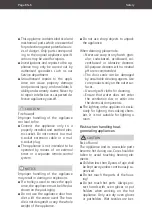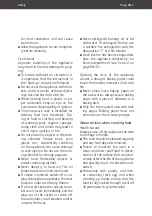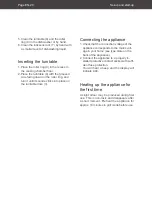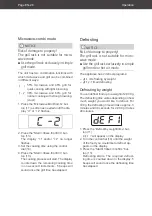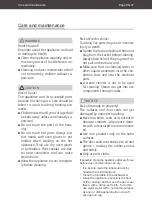
Cooking methods
Page EN-16
Cooking methods
The correct cooking
temperature
Given that microwaves react with varying in-
tensity to water, fat and sugar, the cooking
time depends significantly on the composition
of the dish.
– Dishes with a high fat or sugar content
(doughnuts, puddings, fruitcakes) cook
through more quickly and reach higher
temperatures faster than other dishes.
Make sure to observe the recommended
cooking time as otherwise the food will
burn and damage the appliance.
– Dishes that have a high water content (fish,
vegetables, sauces) cook faster than “dry”
dishes.
– “Dry” dishes (rice, grain products, dried
beans) cook very slowly. Please add a little
water to these before cooking.
The correct quantity
The larger the quantity to be prepared, the
longer the cooking time. If, for example, a po-
tato takes 4 minutes, then two potatoes will
take 7 minutes.
Rule of thumb: Twice the quantity requires
approximately twice the amount of time.
– Small food items cook more quickly than
large food items. And food items of equal
size cook through more evenly than food
items of different sizes. If possible, cut all
food into pieces of roughly the same size.
Remember to do this when freezing!
– When defrosting, size and form play a key
role. Small, flat food portions defrost faster
and more evenly than larger, thicker food
portions. During the defrosting process,
separate portions that have already begun
to thaw, as exposed pieces defrost faster.
Order of dishes
To achieve an even result, special attention
must be paid to arranging the food correctly
for cooking:
– Arrange food with several equally sized
pieces (potatoes, meatballs, hamburgers)
in a circle in the container and leave the
middle empty.
– For pieces of different sizes, place the
small or thin pieces in the middle, as these
pieces will be the last to cook.
– For irregularly shaped pieces (e.g. fish)
place the thin or flatter end towards the
middle.
– Put thin meat slices on top of each other
or crosswise.
– Put thicker meat slices and pieces (roast,
sausages, etc.) close together.
– Heat meat juices and sauces in a separate
container; only fill this two thirds full.
Piercing and scoring
Excess pressure can be caused in many dish-
es when heating them through. It is therefore
recommended to pierce or score certain dish-
es, in order to prevent them from bursting.
– Do not microwave eggs in their shells –
unless using special containers which are
commercially available.
– Pierce food with peels or skins (potatoes,
tomatoes, sausages, aubergines, egg
yolks) to prevent it from bursting open.
– Score the skin of whole fish to prevent it
from tearing open.





